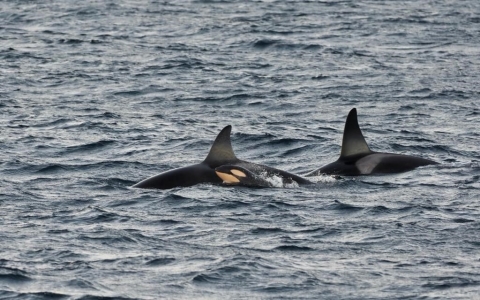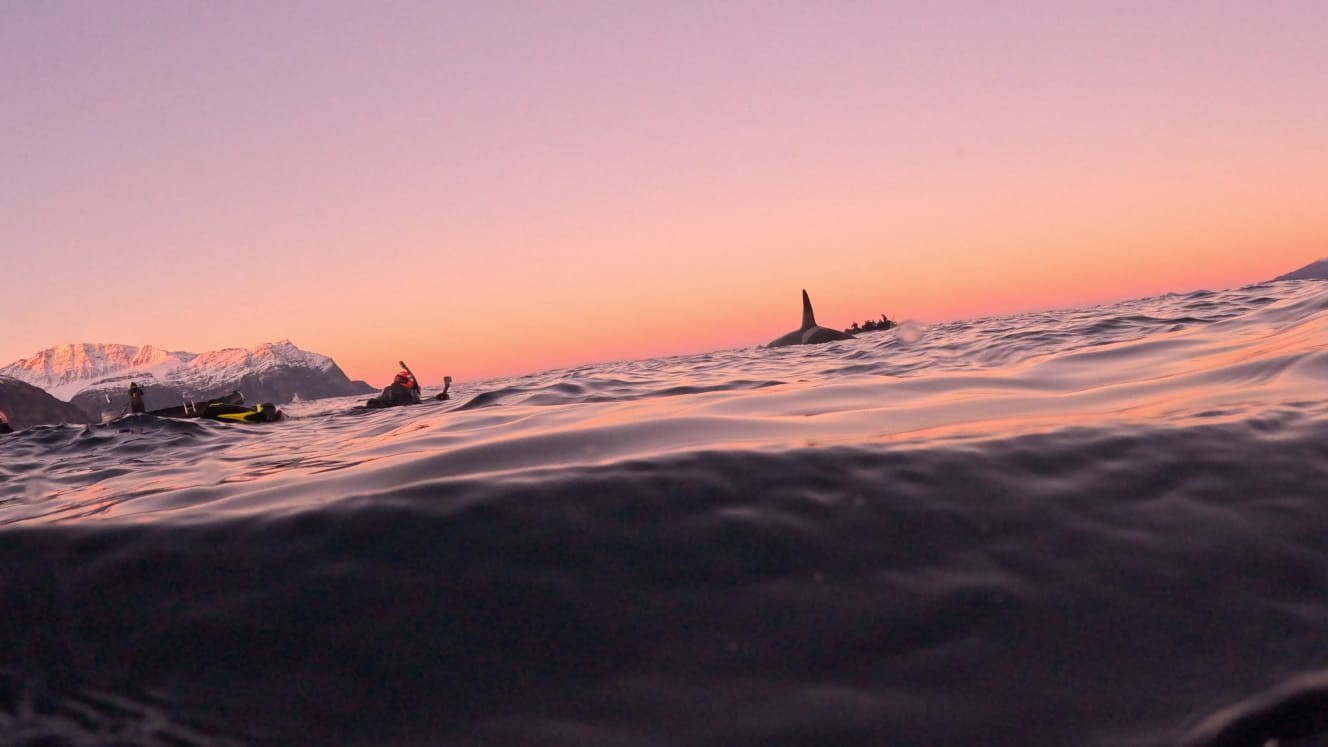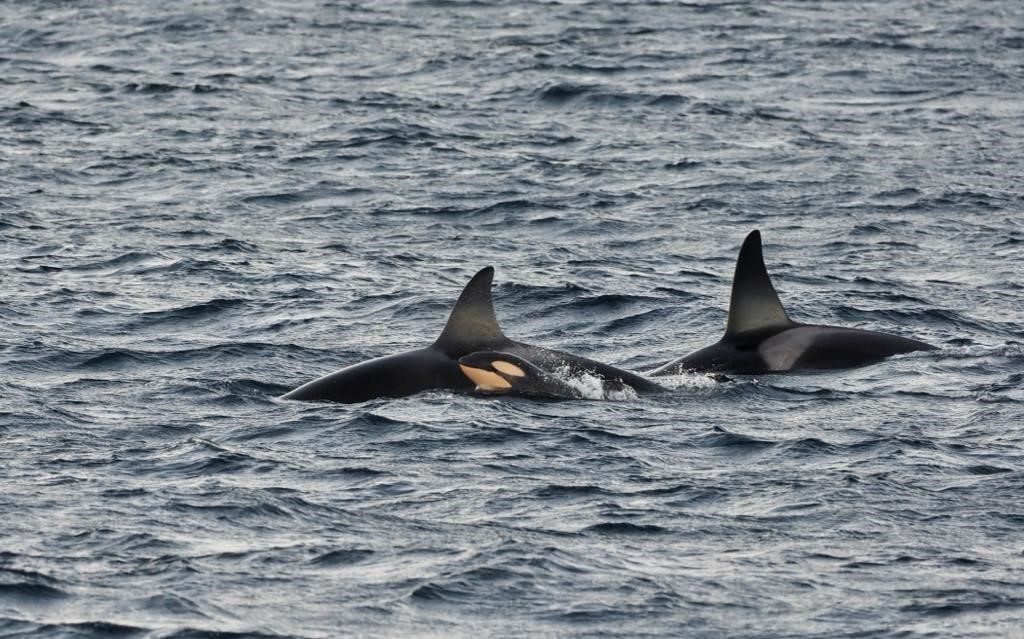LifeWatch collaborates with all-women expedition studying orcas and whales above the Arctic circle
This winter, LifeWatch provided a key contribution to a citizen science initiative studying marine ecosystem change, orca and whale behaviour in northern Norway, 350 kilometres north of the Arctic Circle, during the winter herring run.

Article by Dr. Kate Larkin (EMODnet) and Dr. Elisabeth Debusschere (VLIZ).
The expedition was unique in many ways. The international team was exclusively women, with the 34 ‘SeaWomen’ also representing non-binary and two-spirit peoples, thereby empowering women and minority groups. In addition, the team represented very diverse backgrounds and skillsets that enabled an interdisciplinary programme of activity, connecting marine and wider environmental science with art, photography, storytelling and more, with the core aim to collect new knowledge about marine ecosystems in the region and collectively raise awareness about the Ocean, the effects of climate change on the natural world.

In-water winter snorkeling with orcas. Seawomen Norway 2022 expedition. Photo credit: Aya Walraven.
LifeWatch Belgium and the Flanders Marine Institute (VLIZ), including Dr. Elisabeth Debusschere, contributed expertise and equipment to the ‘SeaWomen’ expedition, including the loaning of a Soundtrap HF 600 (Ocean instruments), which is a hydrophone to monitor underwater sound, marine mammal and other marine life vocalisations. This complimented a behaviour programme focused on killer whales (Orcinus orca) and included in-water winter snorkeling to obtain photos, videos and observations of the orcas and whales, together with marine environmental measurements including ocean physics (temperature and salinity profiles) and eDNA samples.

Killer whales (Orcinus orca), including a calf, photographed in November 2022, Norwegian fjords near Tromsø, Norway, 350km above the Arctic circle. Photo credit: Carol Cotton Blickenstorfer.
Dr. Kate Larkin (marine expert at the European Marine Observation and Data Network Secretariat) was onboard the expedition “This expedition was a completely new approach to positive climate action. All of the women onboard were volunteers, with a common motivation to increase knowledge and societal understanding about the Ocean, and how the Ocean and marine ecosystem is changing as a result of human impact, ranging from climate change to human activities at sea such as fishing, tourism, shipping and more. It was a pleasure to collaborate with VLIZ and LifeWatch Belgium together with other partners and the diverse team of talented women, to make this expedition a reality.”

Dr. Kate Larkin with the Lifewatch Belgium SoundTrap Hydrophone, loaned to SeaWomen for the Norway 2022 expedition. Photo credit: Emma Khan.
The expedition was featured in an article on the UN Ocean Decade online newsletter.
The expedition was unique in many ways. The international team was exclusively women, with the 34 ‘SeaWomen’ also representing non-binary and two-spirit peoples, thereby empowering women and minority groups. In addition, the team represented very diverse backgrounds and skillsets that enabled an interdisciplinary programme of activity, connecting marine and wider environmental science with art, photography, storytelling and more, with the core aim to collect new knowledge about marine ecosystems in the region and collectively raise awareness about the Ocean, the effects of climate change on the natural world.

In-water winter snorkeling with orcas. Seawomen Norway 2022 expedition. Photo credit: Aya Walraven.
LifeWatch Belgium and the Flanders Marine Institute (VLIZ), including Dr. Elisabeth Debusschere, contributed expertise and equipment to the ‘SeaWomen’ expedition, including the loaning of a Soundtrap HF 600 (Ocean instruments), which is a hydrophone to monitor underwater sound, marine mammal and other marine life vocalisations. This complimented a behaviour programme focused on killer whales (Orcinus orca) and included in-water winter snorkeling to obtain photos, videos and observations of the orcas and whales, together with marine environmental measurements including ocean physics (temperature and salinity profiles) and eDNA samples.

Killer whales (Orcinus orca), including a calf, photographed in November 2022, Norwegian fjords near Tromsø, Norway, 350km above the Arctic circle. Photo credit: Carol Cotton Blickenstorfer.
Dr. Kate Larkin (marine expert at the European Marine Observation and Data Network Secretariat) was onboard the expedition “This expedition was a completely new approach to positive climate action. All of the women onboard were volunteers, with a common motivation to increase knowledge and societal understanding about the Ocean, and how the Ocean and marine ecosystem is changing as a result of human impact, ranging from climate change to human activities at sea such as fishing, tourism, shipping and more. It was a pleasure to collaborate with VLIZ and LifeWatch Belgium together with other partners and the diverse team of talented women, to make this expedition a reality.”

Dr. Kate Larkin with the Lifewatch Belgium SoundTrap Hydrophone, loaned to SeaWomen for the Norway 2022 expedition. Photo credit: Emma Khan.
The expedition was featured in an article on the UN Ocean Decade online newsletter.



